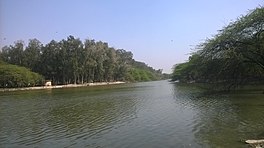ਸੰਜੇ ਝੀਲ
ਸੰਜੇ ਝੀਲ ਇੱਕ ਬਨਾਵਟੀ ਝੀਲ ਹੈ ਜੋ ਦਿੱਲੀ ਵਿਕਾਸ ਅਥਾਰਟੀ (DDA) ਦੁਆਰਾ ਪੂਰਬੀ ਦਿੱਲੀ, ਭਾਰਤ ਵਿੱਚ ਤ੍ਰਿਲੋਕਪੁਰੀ ਵਿੱਚ ਵਿਕਸਤ ਕੀਤੀ ਗਈ ਹੈ, [6] ਮਯੂਰ ਵਿਹਾਰ ਰਿਹਾਇਸ਼ੀ ਖੇਤਰ ਨਾਲ ਲੱਗਦੀ ਹੈ। [7] ਇਹ ਝੀਲ 69 hectares (170 acres) ਜੰਗਲੀ ਖੇਤਰ ਦੇ ਵਿਚਕਾਰ ਲਗਭਗ 17 hectares (42 acres) ਦੇ ਖੇਤਰ ਵਿੱਚ ਫੈਲੀ ਹੋਈ ਹੈ, ਜਿਸਨੂੰ ਸੰਜੇ ਲੇਕ ਪਾਰਕ ਵੀ ਕਿਹਾ ਜਾਂਦਾ ਹੈ। [2] ਸੰਜੇ ਝੀਲ ਨੂੰ 1970 [8] ਵਿੱਚ ਡੀਡੀਏ ਦੁਆਰਾ ਵਿਕਸਤ ਕੀਤਾ ਗਿਆ ਸੀ ਅਤੇ 1982 ਵਿੱਚ ਖੋਲ੍ਹਿਆ ਗਿਆ ਸੀ [2] ਝੀਲ ਕੁਝ ਪਰਵਾਸੀ ਪੰਛੀਆਂ ਨੂੰ ਆਕਰਸ਼ਿਤ ਕਰਦੀ ਹੈ [9] ਅਤੇ ਇਸ ਵਿੱਚ ਬਹੁਤ ਸਾਰੇ ਦੇਸੀ ਰੁੱਖ ਹਨ। [10] ਸੈਰ ਕਰਨ ਦੇ ਸ਼ੌਕੀਨਾਂ ਵਿੱਚ ਇੱਕ ਚੰਗੀ ਤਰ੍ਹਾਂ ਤਿਆਰ ਕੀਤਾ ਗਿਆ ਫਿਟਨੈਸ ਟਰੈਕ ਬਹੁਤ ਮਸ਼ਹੂਰ ਹੈ।
| ਸੰਜੇ ਝੀਲ | |
|---|---|
 ਨਵੀਂ ਦਿੱਲੀ, ਭਾਰਤ ਵਿੱਚ ਸੰਜੇ ਝੀਲ | |
| ਸਥਿਤੀ | ਤ੍ਰਿਲੋਕਪੁਰੀ, ਪੂਰਬੀ ਦਿੱਲੀ, ਭਾਰਤ |
| ਗੁਣਕ | 28°36′51″N 77°18′14″E / 28.61417°N 77.30389°E |
| Type | ਬਨਾਵਟੀ ਝੀਲ |
| ਵ੍ਯੁਪੱਤੀ | Sanjay Gandhi[1][2] |
| ਪ੍ਰਬੰਧਨ ਏਜੰਸੀ | DDA[3] (1982-2009) Delhi Tourism Department (2009 – present)[4] |
| ਬਣਨ ਦੀ ਮਿਤੀ | 1982[1] |
| Surface area | 17 ha (0.066 sq mi)[5] |
| Settlements | ਦਿੱਲੀ |
ਸੰਜੇ ਝੀਲ ਪਾਰਕ ਨਾਲ ਲੱਗਦੀ ਝੀਲ, ਪੂਰਬੀ ਪਾਸੇ ਕਲਿਆਣਪੁਰੀ ਅਤੇ ਤ੍ਰਿਲੋਕਪੁਰੀ ਦੀਆਂ ਰਿਹਾਇਸ਼ੀ ਕਲੋਨੀਆਂ ਅਤੇ ਪੱਛਮੀ ਪਾਸੇ ਮਯੂਰ ਵਿਹਾਰ ਨਾਲ ਘਿਰੀ ਹੋਈ ਹੈ। [11] [4] ਸੰਜੇ ਝੀਲ ਮੀਂਹ ਦੇ ਪਾਣੀ ਨਾਲ ਭਰੀ ਇੱਕ ਵੱਡੀ ਝੀਲ ਹੈ। ਕਦੇ-ਕਦਾਈਂ, ਪਿੱਛਲੀ ਵਗਦੀ ਯਮੁਨਾ ਦੁਆਰਾ ਪਾਣੀ ਦੀ ਸਪਲਾਈ ਵਧਾਈ ਜਾਂਦੀ ਸੀ। ਹੜ੍ਹਾਂ ਦੌਰਾਨ, ਇਸ ਨੂੰ ਹਿੰਡਨ ਨਦੀ ਚੈਨਲ ਰਾਹੀਂ ਵੀ ਪਾਣੀ ਮਿਲਿਆ।
ਭੂਗੋਲ
ਸੋਧੋਹਰ ਸਾਲ ਫਰਵਰੀ ਦੇ ਅੰਤ ਤੱਕ ਇੱਥੇ ਵੱਖ-ਵੱਖ ਕਿਸਮਾਂ ਦੇ ਪੰਛੀ ਦੇਖੇ ਜਾ ਸਕਦੇ ਹਨ। [12] ਸਥਾਨਕ ਪੰਛੀਆਂ ਦੇ ਅਨੁਸਾਰ, ਝੀਲ 90 ਕਿਸਮਾਂ ਦੇ ਪੰਛੀਆਂ ਦੀ ਮੇਜ਼ਬਾਨੀ ਕਰਦੀ ਹੈ। [13] ਸ਼ਵੇਲਰ, ਪਿਨਟੇਲ, ਕਾਮਨ ਪੋਚਾਰਡ, ਟੂਫਟਡ ਪੋਚਾਰਡ, ਕਾਮਨ ਟੀਲ, ਇੰਡੀਅਨ ਸਪਾਟ-ਬਿਲਡ ਡਕ, ਪੀਲੇ ਹੈੱਡਡ ਵੈਗਟੇਲ ਅਤੇ ਪਾਈਡ ਵੈਗਟੇਲ ਕੁਝ ਪੰਛੀ ਹਨ ਜੋ ਆਮ ਤੌਰ 'ਤੇ ਝੀਲ 'ਤੇ ਆਉਂਦੇ ਹਨ । [12] ਪ੍ਰਵਾਸੀ ਪੰਛੀ ਜ਼ਿਆਦਾਤਰ ਝੀਲ ਦੇ ਪੂਰਬੀ ਹਿੱਸੇ ਵਿੱਚ ਆਉਂਦੇ ਹਨ, ਕਿਉਂਕਿ ਪਾਣੀ ਡੂੰਘਾ ਹੈ ਅਤੇ ਇਹ ਇਲਾਕਾ ਮਨੁੱਖੀ ਪਰੇਸ਼ਾਨੀਆਂ ਤੋਂ ਮੁਕਤ ਹੈ। [12]
ਹਵਾਲੇ
ਸੋਧੋ- ↑ 1.0 1.1 Miller, Sam (October 2010). Delhi: Adventures in a Megacity (PB) (in ਅੰਗਰੇਜ਼ੀ). Penguin Books India. p. 153. ISBN 9780143415534. Retrieved 29 September 2016.
- ↑ 2.0 2.1 2.2 Kunal, Ranjan (12 March 2014). "Urbanization takes a toll on Sanjay Lake". DNA. Daily News & Analysis. Retrieved 29 September 2016.
- ↑ Context: Built, Living, and Natural (in ਅੰਗਰੇਜ਼ੀ). DRONAH. 2005. p. 51. Retrieved 29 September 2016.
- ↑ 4.0 4.1 Staff Reporter (20 January 2014). "The story of a disappearing Sanjay Lake". The Hindu (in Indian English). Retrieved 29 September 2016.
- ↑ Shukla, Siddheshwar (14 May 2012). "Sanjay Lake on last legs?". Millennium Post. Retrieved 29 September 2016.
- ↑ Jain, Ashok Kumar (2009). Low Carbon City: Policy, Planning and Practice (in ਅੰਗਰੇਜ਼ੀ). Discovery Publishing House. p. 314. ISBN 9788183564687.
- ↑ Environment Education (in ਅੰਗਰੇਜ਼ੀ). APH Publishing. 2007. ISBN 9788131302835. Retrieved 29 September 2016.
- ↑ "Sanjay lake -- dying silently". Centre for Science and Environment. 2012.
- ↑ Tankha, Madhur (15 April 2014). "A wetland in East Delhi that even migratory birds shun". The Hindu (in Indian English). Retrieved 29 September 2016.
- ↑ "Landmark Greens: Sanjay Lake". Delhi Development Authority. Archived from the original on 2013-07-03. Retrieved 2023-05-15.
- ↑ Garg, Chitra (2007). Travel India : a complete guide to tourist. New Delhi: Lotus Press. p. 185. ISBN 978-8183820844.
- ↑ 12.0 12.1 12.2 Ranjan, Kunal (12 March 2014). "Will migratory birds come to Sanjay Lake next year?". Daily News & Analysis. Retrieved 29 September 2016.
- ↑ Kumar, Pratik (17 January 2016). "Adventure park spells bad news for birds here". Deccan Herald. DHNS. Retrieved 29 September 2016.
ਬਾਹਰੀ ਲਿੰਕ
ਸੋਧੋ- ਸੰਜੇ ਝੀਲ ਵਿਕੀਮਪਿਆ